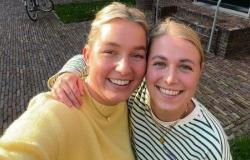Nice steps
The hospital has been working on home monitors for ‘its own’ COPD patients for almost two years, says pulmonologist Hans Hardeman. “We have already taken great steps during this period when it comes to better guidance via the app, improving care processes and concrete agreements about outpatient visits. Normally a patient visits the outpatient clinic 2 to 3 times a year. The goal now is for a patient to visit the nurse specialist once a year and the pulmonologist once every 12 to 18 months. And only in between if things don’t go well. Our ambition is that 50% of hospital patients with COPD participate in home monitoring.”
Alarm
Hardeman explains how home monitoring can reduce the number of outpatient visits. “In practice, people complete the app, first weekly and later weekly or monthly (or daily after admission or in case of more complaints). If an alarm goes off because there are more complaints, the home monitoring nurses will call the patient. Often the patient can be helped with coaching or with an additional adjustment according to the lung attack action plan they already have. After 2 or 3 days there will be another check, via the app, by telephone or live. And if all goes well, they go back to the normal way of home monitoring.”
Decline
St. Antonius itself does not yet have figures on the results of home monitoring, but Hardeman refers to the figures of the Amsterdam OLVG, which introduced this form of care somewhat earlier. Fewer ER admissions, fewer outpatient clinic visits and fewer admissions were seen there. The decrease was always 30-50%. In addition, it is expected that the disease burden will decrease for the entire population, due to better coaching, more self-management of patients and faster intervention in lung attacks.
Feeling confident
“Patients are certainly happy with home monitoring,” says Hardeman. It makes them feel confident and gives them much more information about their disease. They appreciate that. And there is another important aspect for the quality of life of people with COPD. “What we see in the group of patients with home monitoring: they are more unstable than we suspected. Patients who we thought were doing quite well turned out to have a very high complaint score on the app. So high that you say: ‘This is uncontrolled COPD’. You see that people apparently accept these complaints, because they have slowly worsened. So it is already a benefit if you can do something for these patients.”
COPD@home
When COPD patients are stable, they normally return to the doctor. “That’s not possible now. In any case, not with home monitoring, because the first line in our region has not yet been connected.” This is now changing with the new study. “In the COPD@home study, we are examining whether we can also do this central monitoring for general practitioners. The idea is that general practitioners include their patients according to our protocol. That is possible, because the protocol for general practitioners is no different from ours: patients receive an initial phase with additional information, a number of lessons about their illness, advice on how to take medication and then you enter into low-frequency monitoring. Unless you’re not doing well.”
High disease burden
In the study, Hardeman focuses mainly on COPD patients with a somewhat higher disease burden. Does home monitoring work, and what benefits does it bring to the patient? What communication and contact moments are needed? What does it cost GPs in terms of effort and what is the return? But also: is this way of working feasible for the GP? Is it workable? “Maybe logging into the monitoring app for general practitioners is not that user-friendly at all and secure email works better, we will all see that in the study.”
Hassle
“I can say that it is very easy for healthcare providers to log in to the home measurement app, but I do that here in the hospital every day. I simply have a button in my EPD that immediately opens the home measurement app with the right patient. Perhaps that is quite a hassle for a GP with two home monitoring patients per year. We will see that in this study. We also hope to see indications that patients in primary care are gaining more control over their illness, which will reduce healthcare consumption.”
Central monitoring
Ultimately, St. Antonius wants to monitor patients from a central point. That could be in the hospital, but that doesn’t have to be. “We have many more hospitals here in the region. For example, 24/7 monitoring is now also being considered, and monitoring where patients can go home with antibiotics directly from the Emergency Department. As Santeon hospitals we also try to monitor each other. And if the first line can benefit from this, it is much more efficient.”
Zero line
“And that is necessary,” Hardeman emphasizes. “We expect 25-30% demographic growth in COPD patients, simply due to aging. So we have to do something and hopefully this is part of the solution. If we can ensure that patients have fewer lung attacks, they will also visit their GP less often. If we ensure that they raise the alarm sooner and we can help them with a telephone contact of 5 to 10 minutes, then that will save them worry. If we can maintain baseline in terms of admissions and ER visits, then we’ve done a great job. Then we will have absorbed the entire demographic growth.”
Tags: Antonius Hospital investigating home monitoring COPD general practitioners
-




